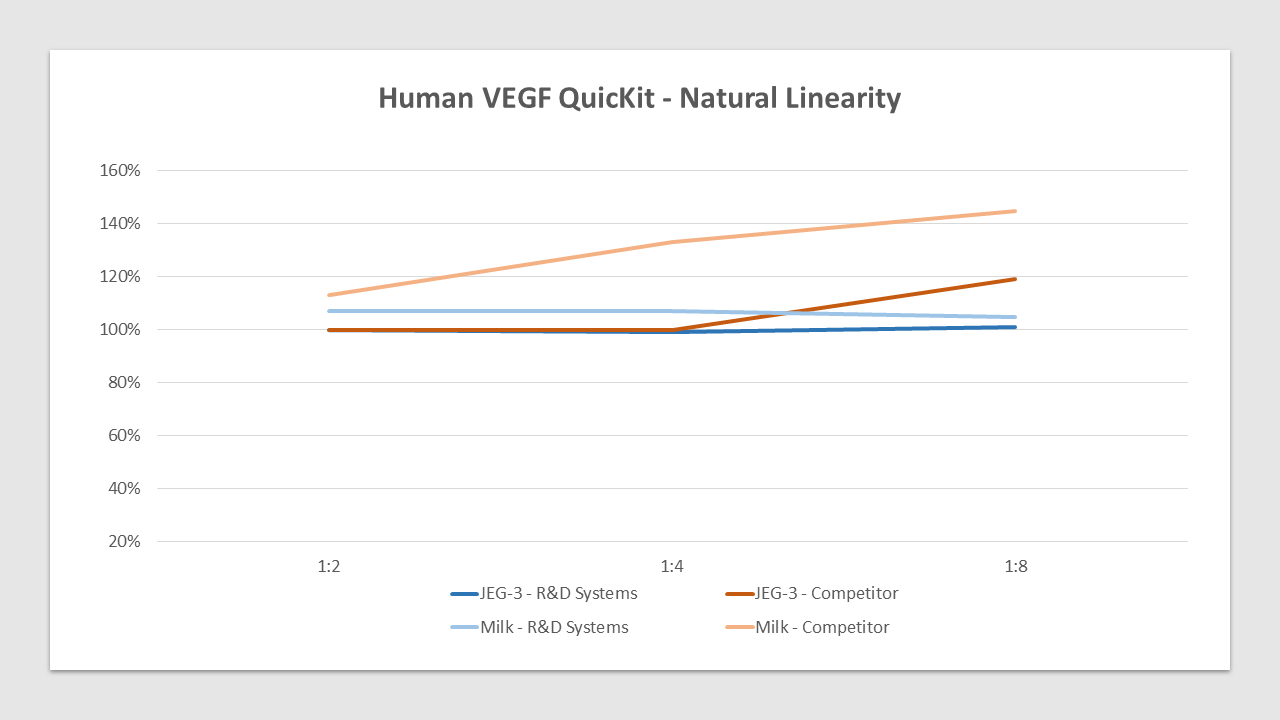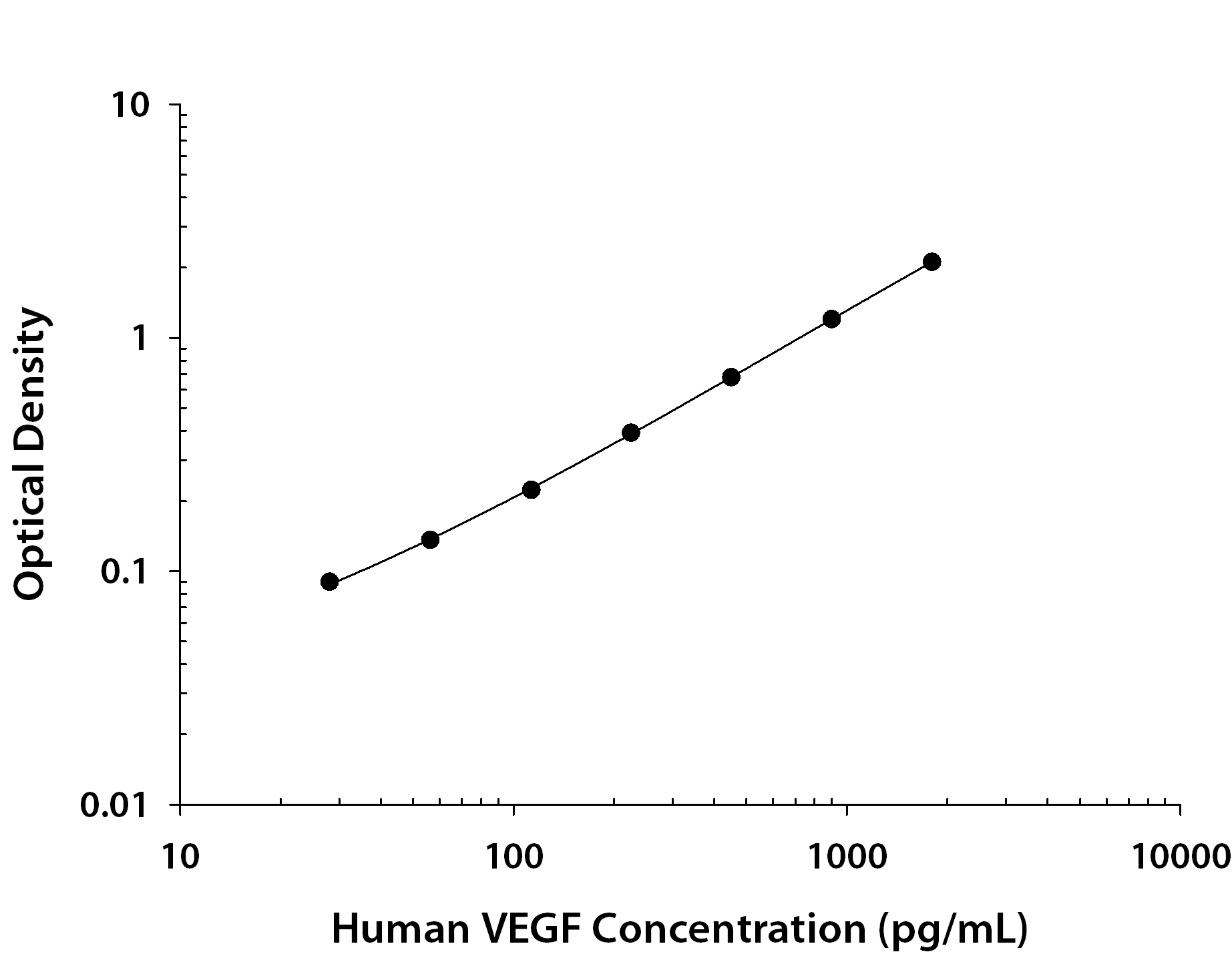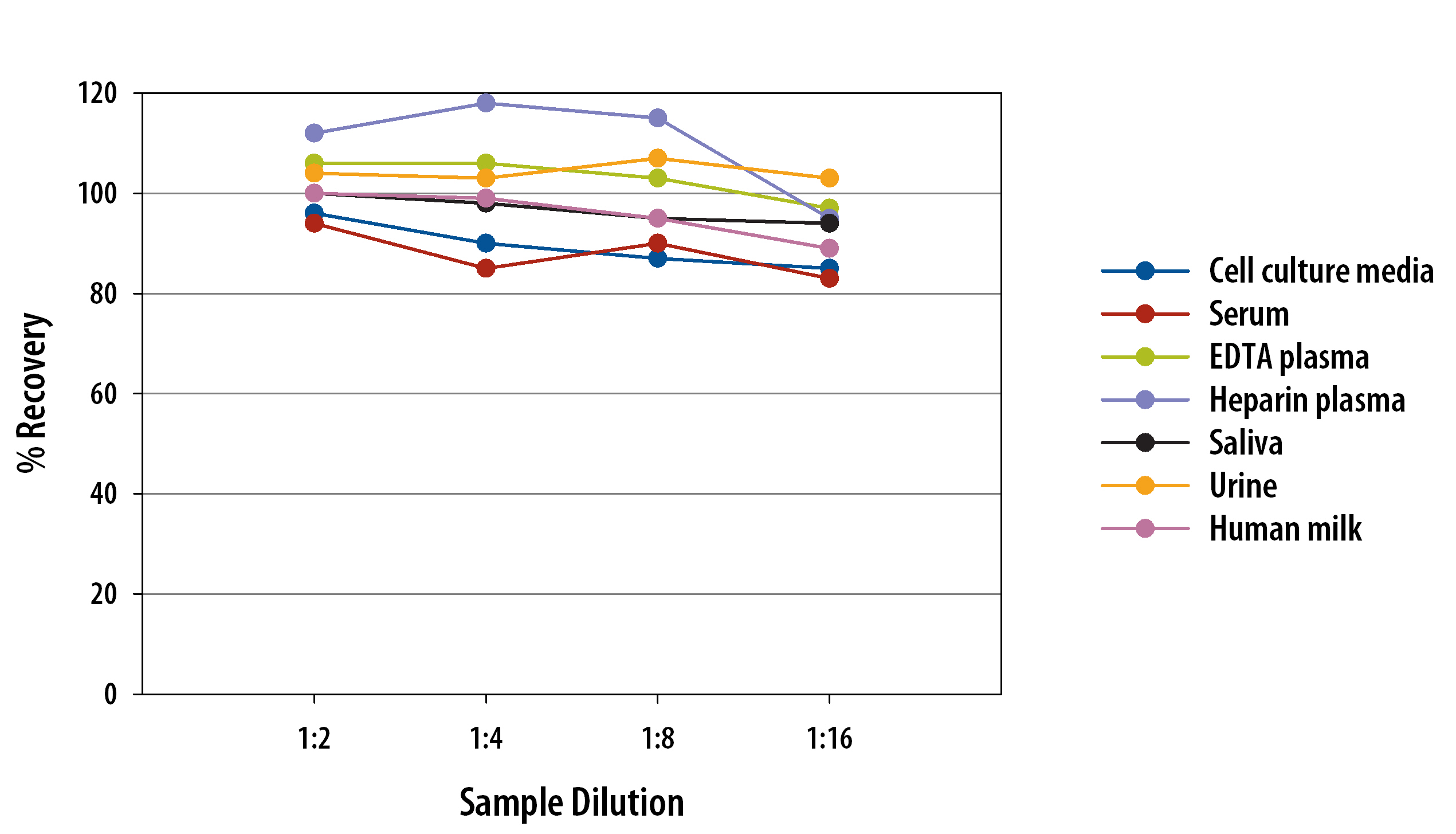Human VEGF Quantikine QuicKit ELISA Summary
Product Summary
Precision
Cell Culture Supernates, Serum, EDTA Plasma, Heparin Plasma, Saliva, Urine, Human Milk
| Intra-Assay Precision | Inter-Assay Precision | |||
|---|---|---|---|---|
| Sample | 1 | 2 | 1 | 2 |
| n | 20 | 20 | 10 | 10 |
| Mean (pg/mL) | 209 | 1193 | 203 | 1216 |
| Standard Deviation | 7.45 | 35.1 | 18.3 | 56.5 |
| CV% | 3.6 | 2.9 | 9 | 4.6 |
Recovery
The recovery of human VEGF spiked to three levels in samples throughout the range of the assay was evaluated.
| Sample Type | Average % Recovery | Range % |
|---|---|---|
| Cell Culture Media (n=4) | 99 | 94-104 |
| EDTA Plasma (n=2) | 83 | 79-88 |
| Heparin Plasma (n=2) | 77 | 70-81 |
| Human Milk (n=2) | 102 | 98-105 |
| Saliva (n=2) | 104 | 97-115 |
| Serum (n=2) | 79 | 74-84 |
| Urine (n=2) | 78 | 70-85 |
Linearity
Scientific Data
 View Larger
View Larger
Human VEGF QuicKit ELISA Spiked Linearity Competitor Comparison Samples containing VEGF were diluted with appropriate Calibrator Diluent to produce samples with values within the dynamic range of the assay. The linearity is between 99%-107% compared to 100%-145% for the top competitor.
Product Datasheets
Preparation and Storage
Background: VEGF
Vascular endothelial growth factor (VEGF or VEGF-A), also known as vascular permeability factor (VPF), is a potent mediator of both angiogenesis and vasculogenesis in the fetus and adult (1-3). It is a member of the PDGF family that is characterized by the presence of eight conserved cysteine residues in a cystine knot structure and the formation of antiparallel disulfide-linked dimers (4). Humans express alternately spliced isoforms of 121, 145, 165, 183, 189, and 206 amino acids (aa) in length (4). VEGF 165 appears to be the most abundant and potent isoform, followed by VEGF 121 and VEGF 189 (3, 4). Isoforms other than VEGF 121 contain basic heparin-binding regions and are not freely diffusible (4). Human VEGF 165 shares 88% aa sequence identity with corresponding regions of mouse and rat VEGF. VEGF is expressed in multiple cells and tissues including skeletal and cardiac muscle (5, 6), hepatocytes (7), osteoblasts (8), neutrophils (9), macrophages (10), keratinocytes (11), brown adipose tissue (12), CD34 + stem cells (13), endothelial cells (14), fibroblasts, and vascular smooth muscle cells (15). VEGF expression is induced by hypoxia and cytokines such as IL-1, IL-6, IL-8, oncostatin M, and TNF-alpha (3, 4, 9, 16). VEGF isoforms are differentially expressed during development and in the adult (3). VEGF dimers bind to two related receptor tyrosine kinases, VEGF R1 (also called Flt-1) and VEGF R2 (Flk-1/KDR), and induce their homodimerization and autophosphorylation (3, 4, 7, 17, 18). These receptors have seven extracellular immunoglobulin-like domains and an intracellular split tyrosine kinase domain. They are expressed on vascular endothelial cells and a range of non-endothelial cells. Although VEGF affinity is highest for binding to VEGF R1, VEGF R2 appears to be the primary mediator of VEGF angiogenic activity (3, 4). VEGF165 also binds the semaphorin receptor, neuropilin-1, which promotes complex formation with VEGF R2 (19). VEGF is best known for its role in vasculogenesis. During embryogenesis, VEGF regulates the proliferation, migration, and survival of endothelial cells (3, 4), thus regulating blood vessel density and size, but playing no role in determining vascular patterns. VEGF promotes bone formation through osteoblast and chondroblast recruitment and is also a monocyte chemoattractant (20-22). After birth, VEGF maintains endothelial cell integrity and is a potent mitogen for micro- and macro-vascular endothelial cells. In adults, VEGF functions mainly in wound healing and the female reproductive cycle (3). In diseased tissues, VEGF promotes vascular permeability. It is thus thought to contribute to tumor metastasis by promoting both extravasation and tumor angiogenesis (23, 24). Various strategies have been employed therapeutically to antagonize VEGF-mediated tumor angiogenesis (25). Circulating VEGF levels correlate with disease activity in autoimmune diseases such as rheumatoid arthritis, multiple sclerosis and systemic lupus erythematosus (26).
Citation for Human VEGF Quantikine QuicKit ELISA
R&D Systems personnel manually curate a database that contains references using R&D Systems products. The data collected includes not only links to publications in PubMed, but also provides information about sample types, species, and experimental conditions.
1 Citation: Showing 1 - 1
-
Chaperone Copolymer Assisted G-Quadruplex-Based Signal Amplification Assay for Highly Sensitive Detection of VEGF
Authors: J Han, C Fang, P Ouyang, Y Qing, Y Yang, H Li, Z Wang, J Du
Biosensors, 2022-04-20;12(5):.
Species: Human
Sample Types: Serum
FAQs
No product specific FAQs exist for this product, however you may
View all ELISA FAQsReviews for Human VEGF Quantikine QuicKit ELISA
There are currently no reviews for this product. Be the first to review Human VEGF Quantikine QuicKit ELISA and earn rewards!
Have you used Human VEGF Quantikine QuicKit ELISA?
Submit a review and receive an Amazon gift card.
$25/€18/£15/$25CAN/¥75 Yuan/¥2500 Yen for a review with an image
$10/€7/£6/$10 CAD/¥70 Yuan/¥1110 Yen for a review without an image








